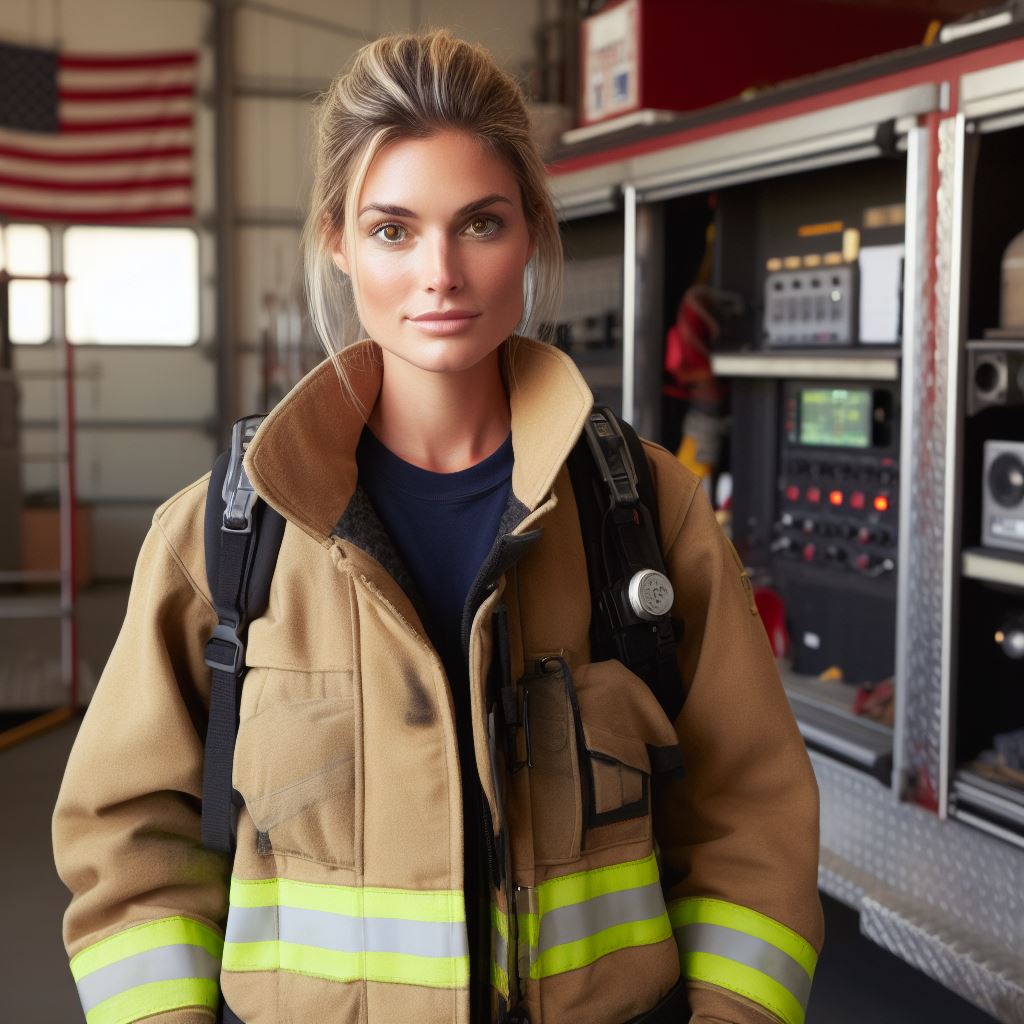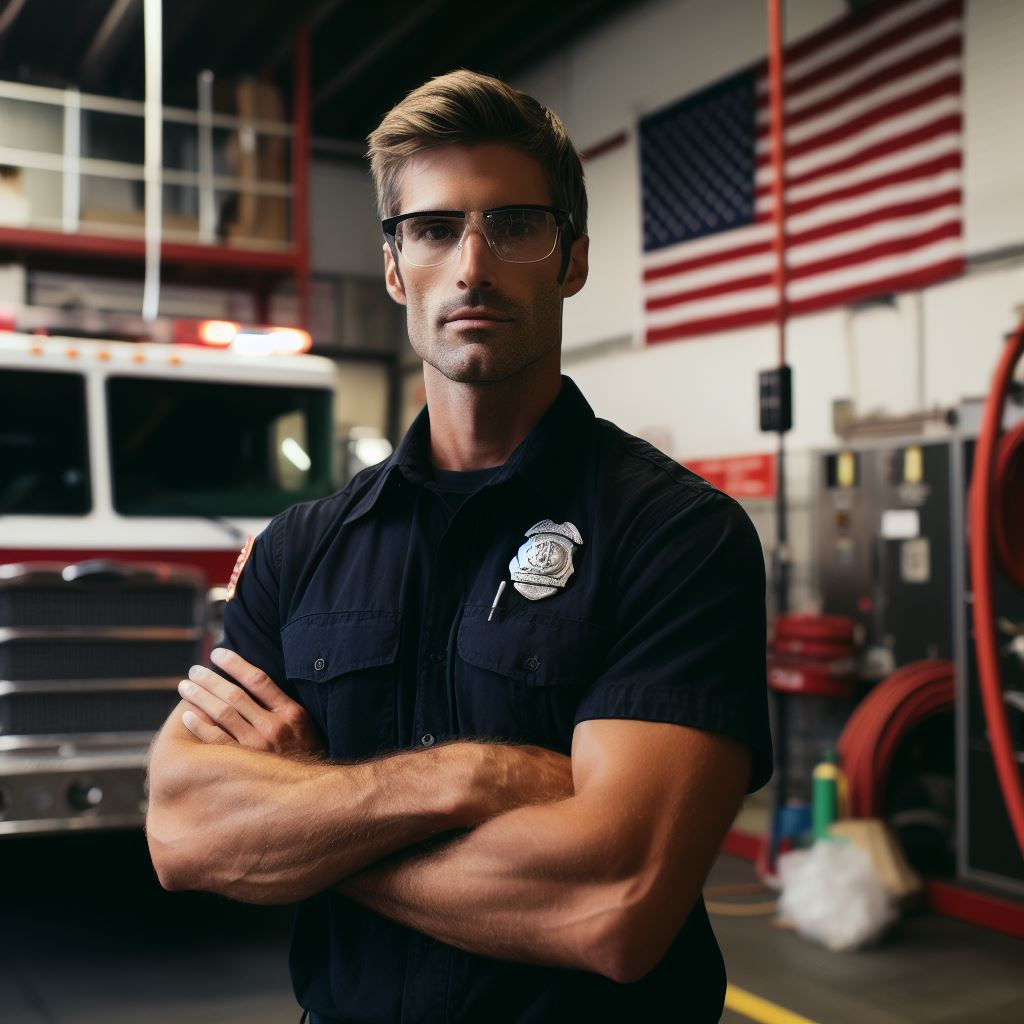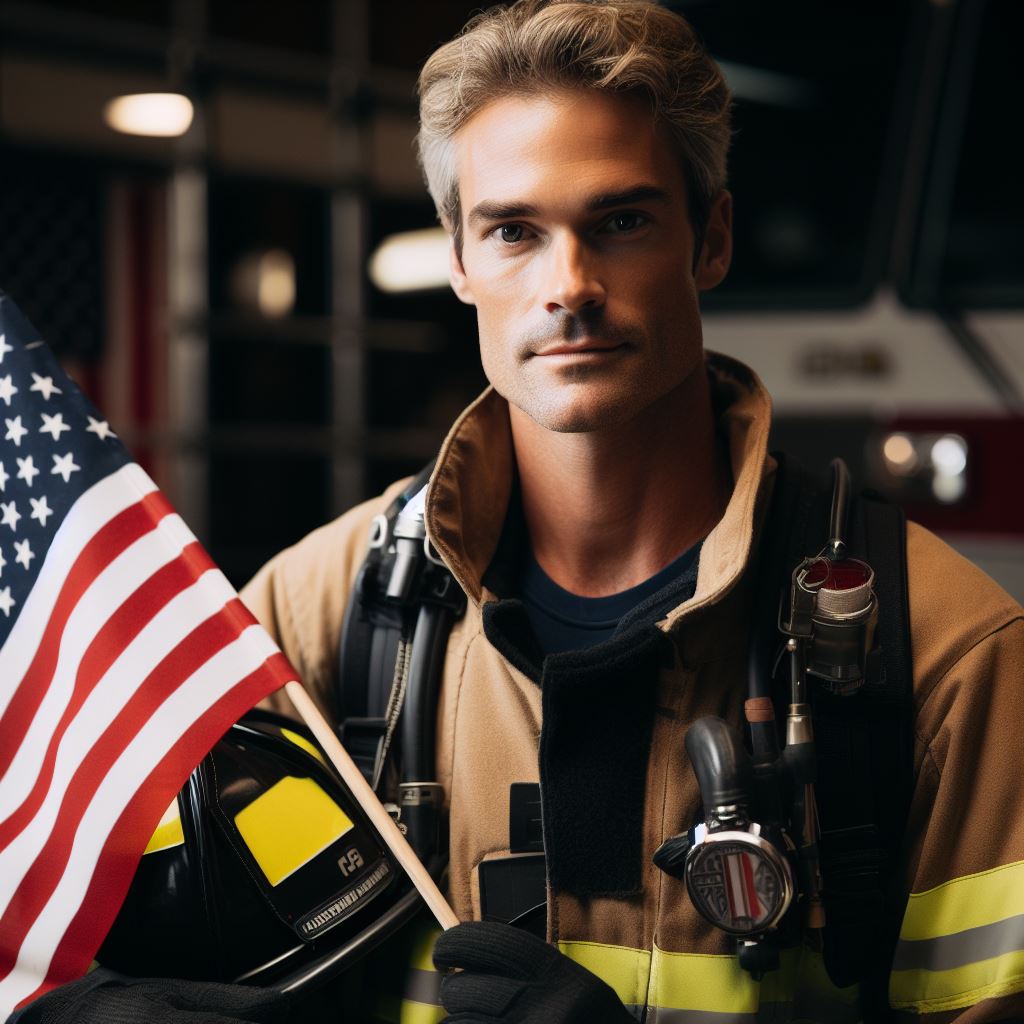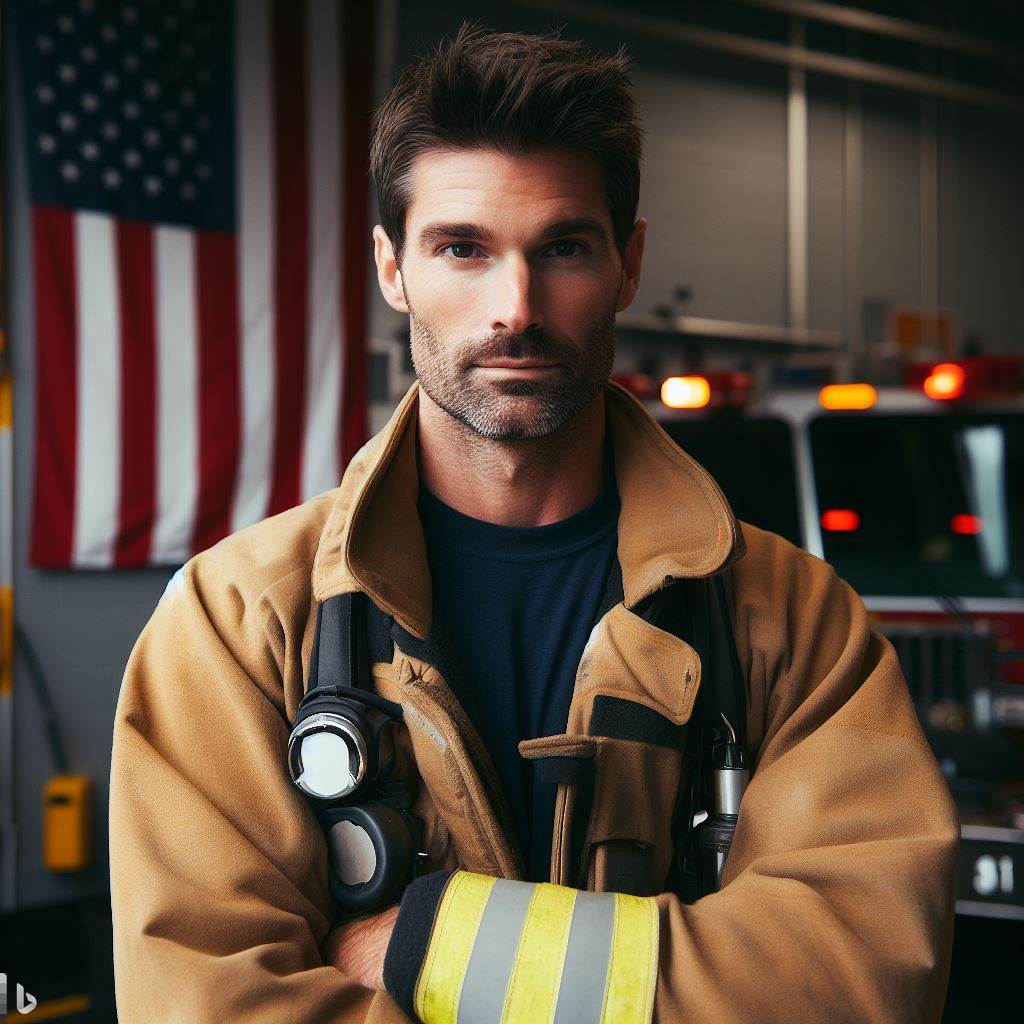Introduction
Why firefighting is a challenging profession
Firefighting is a challenging profession that requires physical and mental strength.
However firefighting is not for the faint-hearted. It is a demanding profession that requires individuals to face dangerous situations head-on.
The physical and mental strength needed to be a firefighter cannot be underestimated.
Fires can be unpredictable and chaotic, and firefighters must be prepared to handle any situation that comes their way.
Importance of possessing key skills
Possessing key skills is crucial for firefighters to ensure their safety and save lives.
However, firefighting is not just about courage and bravery. Possessing key skills is vital for these heroes to effectively carry out their duties.
One of the most essential skills is the ability to work well under pressure. In life-or-death situations, firefighters must remain calm and make split-second decisions.
They need to think critically and assess the situation accurately.
Communication skills are also imperative. Firefighters must effectively communicate with their team members and superiors to coordinate efforts and ensure everyone’s safety.
Additionally, they need to be able to communicate with the public during emergencies, providing reassurance and clear instructions.
Physical fitness is crucial for firefighters to perform their duties efficiently.
They must possess stamina, strength, and agility to endure physically demanding tasks such as carrying heavy equipment, climbing ladders, and rescuing individuals.
Regular training and exercise are essential to maintain their physical condition.
Furthermore, problem-solving skills are essential for firefighters to assess complex situations quickly and find the best course of action.
They must be adaptable and resourceful to overcome obstacles and find solutions in high-pressure environments.
In addition, firefighting is a challenging profession that demands individuals to possess key skills.
These skills include the ability to work under pressure, effective communication, physical fitness, and problem-solving.
With these skills, firefighters can ensure their own safety and save lives in the face of danger.
Physical Fitness and Stamina
Importance of being in good physical condition
- Physical fitness plays a crucial role in the performance of firefighters.
- Being in good physical condition allows firefighters to respond quickly and effectively to emergency situations.
- Firefighters often face physically demanding tasks, such as carrying heavy equipment and rescuing victims.
- Having good overall fitness reduces the risk of injuries and promotes better job performance.
- Firefighters with good physical condition can better handle the physical stress associated with firefighting.
Regular exercise and fitness training
- Regular exercise helps firefighters maintain or improve their physical fitness levels.
- Firefighters should engage in a combination of cardiovascular exercises, strength training, and flexibility exercises.
- Cardiovascular exercises, like running or cycling, help improve cardiovascular endurance.
- Strength training exercises, such as weightlifting, build muscular strength and power.
- Flexibility exercises, like stretching and yoga, enhance flexibility and mobility.
- Firefighters should incorporate exercise routines that target all major muscle groups and improve overall fitness.
Endurance and stamina requirements for firefighters
- Firefighters must possess high levels of endurance and stamina to perform their duties effectively.
- They often work long hours, sometimes 24-hour shifts, during emergencies.
- Endurance and stamina enable firefighters to sustain physical exertion over prolonged periods.
- Firefighting tasks, such as hose handling, climbing ladders, and carrying heavy equipment, require stamina.
- Firefighters need to be able to work in physically challenging environments, such as extreme heat or smoke-filled areas.
- Regular fitness training and conditioning help enhance endurance and stamina for firefighters.
Most importantly, physical fitness and stamina are vital for firefighters to perform their duties effectively and safely.
Maintaining good physical condition through regular exercise and fitness training allows firefighters to respond promptly to emergencies and handle physically demanding tasks.
Endurance and stamina are crucial for sustaining prolonged physical exertion and working in challenging environments.
By prioritizing physical fitness, firefighters can meet the demanding requirements of their profession and better safeguard their own well-being and the well-being of others.
Fire Suppression Techniques
Knowledge of different types of fires and their behavior
- Firefighters must understand the characteristics and behavior of various types of fires.
- They need to differentiate between fires fueled by different materials, such as wood, flammable liquids, or electrical equipment.
- Knowing the different stages of a fire, including ignition, growth, fully developed, and decay, is essential.
- Understanding how fires spread and react to different firefighting techniques is crucial for effective suppression.
- Being knowledgeable about fire behavior helps firefighters make informed decisions to control and extinguish fires safely.
Understanding of fire suppression methods and equipment
- Firefighters must be familiar with various fire suppression methods and the equipment used for each.
- These methods include direct attack, indirect attack, ventilation, and salvage.
- They need to know when to use each method based on the type, size, and location of the fire.
- Understanding the capabilities and limitations of fire suppression tools and equipment is also crucial.
- Knowledge of fire hoses, nozzles, fire extinguishers, and sprinkler systems ensures efficient firefighting operations.
Proper handling of fire extinguishers, hoses, and tools
- Firefighters must be proficient in using and handling fire extinguishers, hoses, and other firefighting tools.
- Knowing how to operate various types of fire extinguishers safely is essential for initial fire control.
- They should be able to select the appropriate fire extinguisher based on the fire’s fuel source.
- Properly handling fire hoses and nozzles ensures effective water delivery and control of the fire.
- Firefighters must also maintain and inspect firefighting tools regularly to ensure their functionality.
In a nutshell, mastering fire suppression techniques is a crucial skill for every firefighter in the United States.
They need a comprehensive understanding of the behavior of different types of fires.
Additionally, they must be familiar with various fire suppression methods and the equipment used for each.
Proper handling of fire extinguishers, hoses, and tools is also essential for effective firefighting operations.
By possessing these key skills, firefighters can protect lives and property while successfully battling fires.
Communication and Teamwork
Importance of effective communication during emergencies
- Clear and concise communication is crucial for firefighters to effectively coordinate during emergencies.
- Communication ensures that resources are allocated appropriately and actions are coordinated.
- Effective communication enables quick decision-making and ensures the safety of both firefighters and civilians.
- Firefighters must be able to communicate with each other, their team leaders, and incident commanders.
- Timely and accurate information shared through effective communication helps prevent chaos and confusion.
- Clear communication allows firefighters to understand the situation, assess risks, and determine the necessary actions.
- During emergencies, effective communication promotes teamwork, ensuring everyone works towards the same goal.
- Firefighters with strong communication skills can relay vital information to other emergency personnel such as paramedics.
- Radios, hand signals, and verbal communication are crucial tools for effective communication during emergencies.
- Good communication skills also allow firefighters to provide reassurance and instructions to individuals affected by the emergency.
Ability to follow instructions and give clear commands
- Firefighters must possess the ability to follow instructions promptly and accurately to ensure the safety of everyone involved.
- Following instructions allows firefighters to act as a cohesive unit, protecting themselves and the public.
- Clear commands from leaders enable firefighters to perform their roles efficiently and without hesitation.
- Firefighters need to understand and implement instructions quickly to prevent delays or mistakes during emergencies.
- The ability to give clear commands is essential for fire officers to direct their team effectively.
- Clear commands are necessary to maintain control over the situation and ensure smooth coordination among firefighters.
- Firefighters should be able to provide instructions in a concise, assertive, and easily understandable manner.
- Following instructions and giving clear commands help in scenario-based training exercises to enhance preparedness.
- The ability to follow instructions and give commands showcases leadership skills within the firefighting team.
- Proper instructions and clear commands minimize confusion, increase situational awareness, and improve overall effectiveness.
Collaboration with other firefighters and emergency personnel
- Firefighters must work collaboratively with their team and other emergency personnel to achieve successful outcomes.
- Collaboration ensures effective utilization of resources and enhances the overall efficiency during emergencies.
- Firefighters need to establish strong working relationships and trust with their colleagues to foster effective collaboration.
- Collaborating with other firefighters allows for the sharing of knowledge, skills, and lessons learned.
- Collaboration within the firefighting community promotes continuous improvement and the development of best practices.
- Effective collaboration enhances the safety of firefighters and improves the chances of rescue for those in need.
- Firefighters should actively contribute to the team’s goals, respect opinions, and communicate openly with their teammates.
- Collaborative relationships with other emergency personnel, such as police and paramedics, facilitate integrated emergency response efforts.
- Successful collaboration requires effective communication, active listening, and a willingness to work together towards a common objective.
- Firefighters who excel in collaboration maintain a strong support network and contribute to a positive work environment.
By effectively communicating, following instructions, and collaborating with others, firefighters maximize their impact during emergency situations.
These key skills promote teamwork, enhance safety, and improve overall outcomes for both firefighters and those they serve.
Problem-Solving and Critical Thinking
Quick decision-making in high-pressure situations
Firefighters are often faced with life and death decisions that require them to think quickly and make split-second choices.
They must have the ability to assess a situation rapidly and determine the best course of action. This skill is essential in order to prevent further harm to individuals and property.
Firefighters must be able to think on their feet and make quick decisions to save lives.
Assessing risks and developing firefighting strategies
As part of their job, firefighters must be able to analyze potential risks and develop effective strategies to combat them.
This requires critical thinking skills as well as the ability to assess the situation from multiple angles.
Firefighters must be able to consider various factors such as the type of fire, the environment, and the available resources.
They must then come up with a plan that maximizes their chances of success while minimizing the risks involved.
Adapting to changing circumstances during emergencies
Emergencies can be unpredictable, and firefighters must be able to adapt to changing circumstances. They must be flexible and able to adjust their strategies on the spot when faced with unexpected challenges.
This requires the ability to think critically and quickly come up with alternative solutions.
Firefighters must be able to think on their feet and make adjustments in real-time to ensure the safety of everyone involved.
Transform Your Career Today
Unlock a personalized career strategy that drives real results. Get tailored advice and a roadmap designed just for you.
Start Nowproblem-solving and critical thinking skills are vital for every firefighter in the United States.
They must be able to make quick decisions, assess risks, and adapt to changing circumstances.
These skills are essential in order to effectively handle high-pressure situations and protect lives and property.
Firefighters must rely on their ability to think critically and come up with effective solutions in order to succeed in their line of work.
Without these skills, firefighters would be ill-equipped to handle the challenges they face every day.
First Aid and Medical Skills
A firefighter must possess key skills in first aid and medical assistance in order to effectively respond to emergencies and provide necessary care to injured individuals.
Knowledge of basic first aid techniques
Firefighters should have a solid understanding of basic first aid techniques to address various injuries and medical emergencies.
- Recognizing signs of injury or illness
- Applying bandages and dressings
- Managing bleeding and controlling wounds
- Providing immediate care for burns and fractures
These skills enable firefighters to stabilize the condition of injured individuals until professional medical help arrives.
Ability to provide medical assistance to injured individuals
Firefighters must be capable of delivering immediate medical assistance to individuals in need, especially in situations where immediate professional medical help is not available.
- Evaluating the severity of injuries and medical conditions
- Administering appropriate treatment and medications
- Monitoring vital signs and ensuring stability
With their comprehensive training, firefighters can effectively provide temporary care and support to injured individuals, potentially saving lives during critical moments.
Understanding of CPR and other life-saving techniques
A crucial skill for every firefighter is the ability to perform cardiopulmonary resuscitation (CPR) and other life-saving techniques.
- Recognizing cardiac arrest and respiratory distress
- Performing effective chest compressions and rescue breathing
- Utilizing automatic external defibrillators (AED) when necessary
By understanding and applying these techniques, firefighters increase the chances of survival for individuals experiencing sudden cardiac arrest or respiratory failure.
On a final note, first aid and medical skills are vital for firefighters to provide immediate and essential care to injured individuals during emergencies.
Their knowledge of basic first aid techniques, ability to provide medical assistance, and understanding of CPR and other life-saving techniques make them indispensable members of the emergency response team.
Read: Women in the U.S. Military: Breaking Barriers & Traditions

Rescue and Extraction Techniques
Familiarity with various rescue equipment and tools
Firefighters must possess a deep understanding of the different rescue equipment and tools used in their line of work. They need to be familiar with their functions, applications, and proper usage.
Hydraulic Tools
Firefighters should be skilled in operating hydraulic tools such as Jaws of Life, spreaders, and cutters. These tools are essential for extricating individuals from vehicles involved in accidents.
Rescue Ladders
Firefighters need to be proficient in using rescue ladders to access elevated areas or as an escape route during emergencies.
They must practice ladder placement, climbing techniques, and securing the ladder properly.
Ropes and Knots
Firefighters should have a comprehensive understanding of ropes and knots for various rescue scenarios. This knowledge enables them to create secure anchor points, rigging systems, and hoisting mechanisms.
Training in safely evacuating trapped individuals
Firefighters play a critical role in safely evacuating trapped individuals during emergencies. They must undergo rigorous training to ensure their competency in executing these rescue techniques.
Search and Rescue
Firefighters must be skilled in conducting search and rescue operations to locate and extract individuals from hazardous environments.
They need to know how to navigate through smoke-filled rooms, collapsed structures, and other dangerous situations.
Transform Your Career Today
Unlock a personalized career strategy that drives real results. Get tailored advice and a roadmap designed just for you.
Start NowConfined Space Rescue
When individuals are trapped in confined spaces like tunnels or collapsed buildings, firefighters need specialized training to safely extricate them.
They should be well-versed in using equipment such as harnesses, ventilation systems, and communication devices.
High-angle Rescue
Firefighters should also be trained in high-angle rescue techniques to rescue individuals from elevated areas such as cliffs, rooftops, or construction sites.
This includes knowledge of rope systems, harnesses, and rappelling methods.
Handling emergencies involving hazardous materials and structures
Firefighters often encounter emergencies related to hazardous materials and structures that require specific skills and knowledge to handle effectively.
Hazmat Response
Firefighters must undergo specialized training to respond to incidents involving hazardous materials. They need to be able to identify, contain, and mitigate the risks associated with these substances.
Structural Collapse
In the event of a building or structural collapse, firefighters must be trained in technical rescue procedures.
They should have knowledge of shoring techniques, breaching tools, and lifting equipment to safely extract individuals trapped in the debris.
Industrial Emergencies
Firefighters need to be equipped with the skills to handle emergencies in industrial settings.
This includes understanding the layout of industrial complexes, knowing how to control hazardous materials, and being aware of potential risks unique to these environments.
In summary, firefighters must possess a range of key skills to effectively carry out their lifesaving duties.
This includes familiarity with rescue equipment, training in safely evacuating trapped individuals, and handling emergencies involving hazardous materials and structures.
By mastering these techniques, firefighters can better protect the lives and property of their communities.
Read: Military Technology: Tools of the Modern American Soldier
Emotional Resilience and Stress Management
Dealing with traumatic experiences and high-stress situation
- They encounter traumatic experiences like witnessing death or injury, which can take a toll on their mental well-being.
- It is crucial for firefighters to remain calm and composed during high-stress situations to make rational decisions.
- Training programs should focus on equipping firefighters with strategies to cope with traumatic experiences.
- Firefighters should learn techniques like deep breathing and visualization to manage stress during emergencies.
Utilizing coping mechanisms to maintain mental well-being
- They should engage in activities that help reduce stress, such as hobbies or physical exercise.
- Cultivating a support system within the firefighting community can provide invaluable emotional support.
- Firefighters should learn healthy strategies to express and process their emotions, like journaling or talking to trusted colleagues.
- Utilizing time management techniques can help firefighters balance their personal and professional lives.
Seeking support and counseling when necessary
- Firefighters should not hesitate to seek professional help when they experience persistent emotional challenges.
- There are counseling services specifically tailored to support the mental health of firefighters.
- Therapy sessions can help firefighters develop effective coping mechanisms and enhance their emotional resilience.
- Peer support programs can provide a safe environment for firefighters to share their experiences and seek advice.
- Mental health should be prioritized by both firefighters and their department, ensuring access to necessary resources.
Read: Financial Planning for U.S. Military Personnel & Families
Continuous Training and Education
A well-trained and knowledgeable firefighter is essential for effectively combating fires and saving lives.
Continuous training and education play a crucial role in maintaining the skills and competencies required in this demanding profession.
Importance of staying updated on firefighting techniques
- Advancements in firefighting techniques occur frequently.
- Staying updated ensures firefighters are equipped with the latest knowledge.
- Important changes in fire codes and regulations often require updated training.
- Being aware of current techniques enables firefighters to adapt to evolving fire situations.
- Regular training updates prepare firefighters to handle new fire hazards and risks.
Participation in regular training exercises and drills
- Practice enhances a firefighter’s ability to respond quickly and efficiently during emergencies.
- Training exercises simulate real-life scenarios, improving decision-making skills under pressure.
- Collaborating with fellow firefighters promotes teamwork and enhances communication during operations.
- Training drills help reinforce standard operating procedures and muscle memory.
- Regular practice enhances physical preparedness for the demanding tasks firefighters encounter.
Pursuing additional certifications and specialized training
- Gaining specialized certifications improves a firefighter’s expertise in specific areas.
- Specialized training provides in-depth knowledge regarding hazardous materials or technical rescue operations.
- Additional certifications demonstrate commitment to professional growth and dedication to the firefighting profession.
- Firefighters with specialized training can contribute expertise during complex emergency situations.
- Pursuing further education promotes career advancement opportunities within the firefighting field.
In essence, continuous training and education are essential components of a firefighter’s professional development.
Staying updated on firefighting techniques, participating in regular drills, and pursuing additional certifications enhance a firefighter’s skills, knowledge, and effectiveness in their critical role.
By investing in continuous learning, firefighters ensure they are fully prepared to tackle the challenges they may face while safeguarding lives and property in their communities.
Read: The Role of the U.S. Coast Guard: Beyond Sea Rescues
Learn More: How Technology is Changing the Role of Security Guards in the USA
Conclusion
Culminating Insights: Essential Skills Every U.S. Firefighter Must Possess
As we conclude our exploration, it’s paramount to reiterate the indispensable skills intrinsic to the role of U.S. firefighters.
Beyond the fire hoses and protective gear, adaptability, teamwork, resilience, and effective communication stand out as the cornerstones of a proficient firefighter.
A profound salute is extended to the men and women who embody dedication and bravery on the front lines, navigating the unpredictable challenges that define the firefighting profession.
Their commitment to safeguarding communities deserves our utmost admiration.
To those aspiring to join the ranks of these extraordinary individuals, this section serves as a guide and an encouragement.
Cultivate these essential skills, for they are not just tools in your toolkit but the very essence of becoming a resilient, adaptable, and effective guardian of public safety.
As you embark on this noble journey, may these skills be your compass, guiding you through the challenges that lie ahead.”




